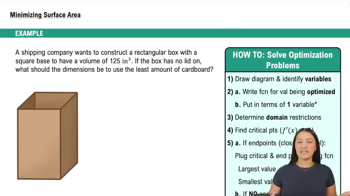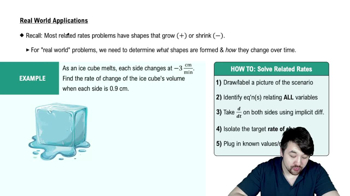Table of contents
- 0. Functions7h 52m
- Introduction to Functions16m
- Piecewise Functions10m
- Properties of Functions9m
- Common Functions1h 8m
- Transformations5m
- Combining Functions27m
- Exponent rules32m
- Exponential Functions28m
- Logarithmic Functions24m
- Properties of Logarithms34m
- Exponential & Logarithmic Equations35m
- Introduction to Trigonometric Functions38m
- Graphs of Trigonometric Functions44m
- Trigonometric Identities47m
- Inverse Trigonometric Functions48m
- 1. Limits and Continuity2h 2m
- 2. Intro to Derivatives1h 33m
- 3. Techniques of Differentiation3h 18m
- 4. Applications of Derivatives2h 38m
- 5. Graphical Applications of Derivatives6h 2m
- 6. Derivatives of Inverse, Exponential, & Logarithmic Functions2h 37m
- 7. Antiderivatives & Indefinite Integrals1h 26m
- 8. Definite Integrals4h 44m
- 9. Graphical Applications of Integrals2h 27m
- 10. Physics Applications of Integrals 2h 22m
4. Applications of Derivatives
Related Rates
Problem 3.11.21
Textbook Question
A spherical snowball melts at a rate proportional to its surface area. Show that the rate of change of the radius is constant. (Hint: Surface area=4πr².)
 Verified step by step guidance
Verified step by step guidance1
Start by identifying the given information: the rate of change of the volume of the snowball is proportional to its surface area. The surface area of a sphere is given by \( A = 4\pi r^2 \).
Express the volume \( V \) of the sphere in terms of its radius \( r \) using the formula \( V = \frac{4}{3}\pi r^3 \).
Differentiate the volume \( V \) with respect to time \( t \) to find \( \frac{dV}{dt} \). Using the chain rule, \( \frac{dV}{dt} = 4\pi r^2 \frac{dr}{dt} \).
Since the rate of change of the volume is proportional to the surface area, we have \( \frac{dV}{dt} = k \cdot 4\pi r^2 \), where \( k \) is a constant of proportionality.
Equate the two expressions for \( \frac{dV}{dt} \): \( 4\pi r^2 \frac{dr}{dt} = k \cdot 4\pi r^2 \). Simplify to find \( \frac{dr}{dt} = k \), showing that the rate of change of the radius is constant.
 Verified video answer for a similar problem:
Verified video answer for a similar problem:This video solution was recommended by our tutors as helpful for the problem above
Video duration:
4mPlay a video:
Was this helpful?
Key Concepts
Here are the essential concepts you must grasp in order to answer the question correctly.
Surface Area of a Sphere
The surface area of a sphere is given by the formula A = 4πr², where r is the radius. This formula indicates that the surface area increases with the square of the radius. Understanding this relationship is crucial because the problem states that the rate of melting is proportional to this surface area, linking the geometry of the sphere to its rate of change.
Recommended video:

Example 1: Minimizing Surface Area
Rate of Change
In calculus, the rate of change refers to how a quantity changes in relation to another variable. In this context, we are interested in how the radius of the snowball changes over time as it melts. By establishing a relationship between the surface area and the radius, we can derive the rate of change of the radius with respect to time.
Recommended video:

Intro To Related Rates
Proportional Relationships
A proportional relationship means that one quantity changes at a constant rate relative to another. In this scenario, the rate at which the snowball melts is proportional to its surface area. This implies that as the surface area decreases, the radius will also change at a consistent rate, leading to the conclusion that the rate of change of the radius remains constant.
Recommended video:

Derivatives Applied To Velocity
Related Videos
Related Practice





